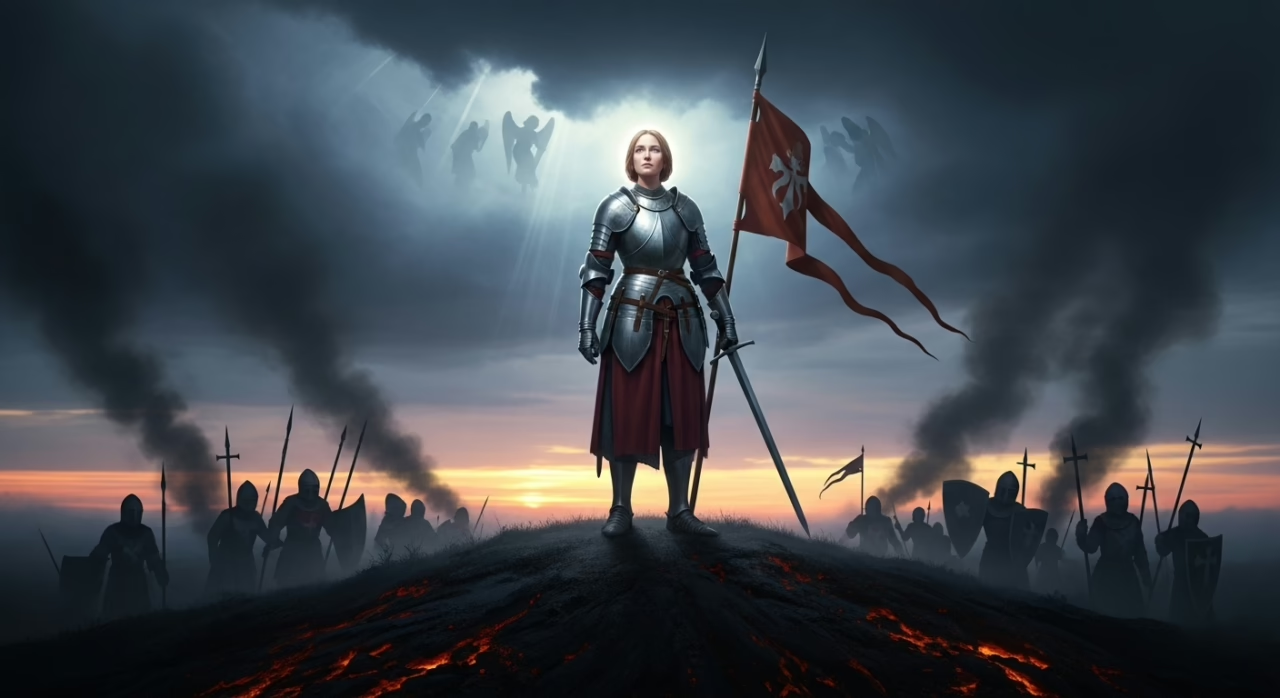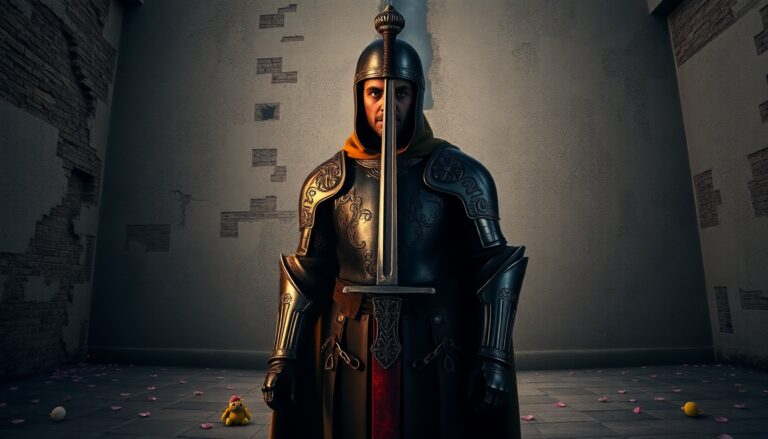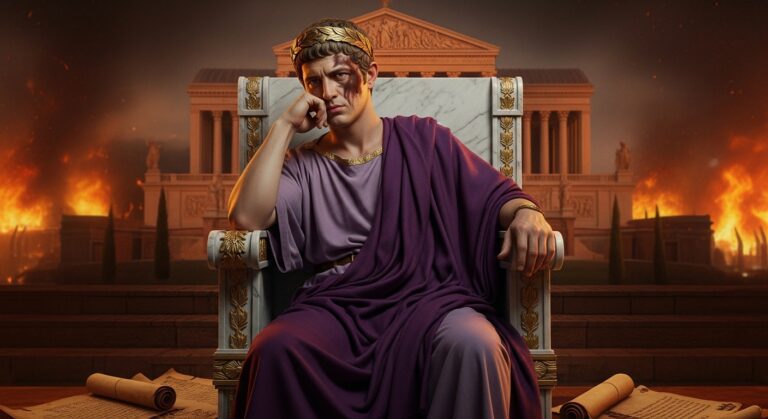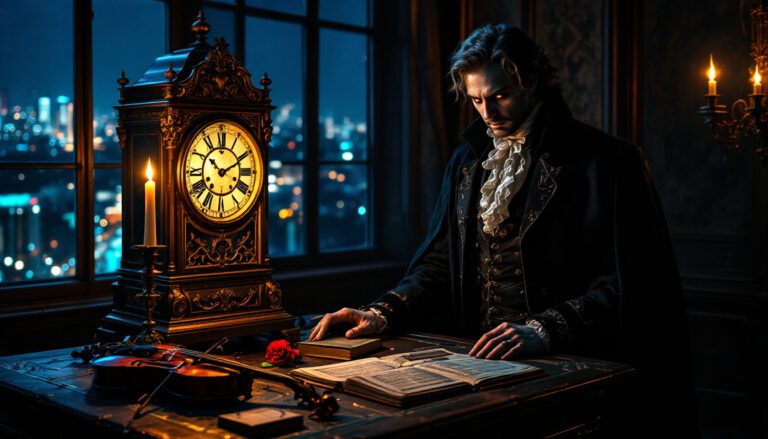Mystery of Joan of Arc: Visions, Battles & Legacy

Joan of Arc: Prophetess or Political Pawn? – Few historical figures embody paradox as completely as Joan of Arc.
Her meteoric rise from peasant girl to military leader defies conventional medieval narratives, while her claims of divine guidance challenge modern secular sensibilities.
The French call her “La Pucelle d’Orléans,” a virgin warrior who altered the course of the Hundred Years’ War through sheer conviction.
Yet beneath her canonical status lies a tapestry of contradictions—political machinations, ecclesiastical controversies, and psychological enigmas—that continue to resist definitive interpretation.
Key Takeaways
Hide- Joan experienced visions of Saints Michael, Catherine, and Margaret beginning at age thirteen, guiding her military strategies.
- At seventeen, she led French forces to a decisive victory at Orléans, reversing France's fortunes in the Hundred Years' War.
- Her rapid transformation from peasant girl to military commander remains one of history's most remarkable leadership stories.
- Despite Charles VII's inaction during her capture, Joan was rehabilitated posthumously in 1456, enhancing her legendary status.
- Her legacy spans nationalist symbol, feminist icon, and cultural phenomenon, appearing in over fifty films and countless artistic works.
Joan of Arc: Saint or Warrior?
Joan of Arc emerged from humble origins in Domrémy, a village in northeastern France, where her claims of divine visions and celestial voices would transform a peasant girl into a figure of profound historical significance.
Her meteoric ascension from obscurity to military leadership defied medieval gender conventions, as commanders and nobles yielded authority to a seventeen-year-old who had convinced the uncrowned Charles VII of her divinely sanctioned mission.
The paradox of Joan’s identity—torn between the martial commander who wielded a sword and the devout mystic who refused to shed blood—established the fundamental tension that would characterize her legacy across centuries.
Origins of the Maid of Orléans
Born around 1412 in the village of Domrémy on the border of Lorraine, Joan of Arc emerged from humble agrarian origins that belied her extraordinary destiny.
While tending her father’s fields at approximately age thirteen, she began experiencing celestial visitations—specifically from Saints Michael, Catherine, and Margaret—who communicated divine messages regarding France’s salvation.
- Vlad the Impaler: Behind the Legend of The Real Dracula?
- The Story of Robin Lee Graham: Sailing the Oceans Alone at Sixteen
- Tamerlane: Legendary Conqueror or Brutal Monster?
- Grigori Rasputin: Saint or Sinner?
- The Enigma of Nikola Tesla: Genius, Visionary, or Mad Scientist?
- John Deydras: The Curious Case of a False King
These mystical encounters, occurring amidst the tumult of the Hundred Years’ War, compelled the illiterate peasant girl to transcend both her social station and gender constraints, initiating the transformation from shepherdess to military leader that would forever alter the course of French history.
Joan of Arc’s Childhood in Domrémy
The medieval village of Domrémy, nestled along the eastern frontier of the Kingdom of France, witnessed the early years of one of history’s most enigmatic figures during the tumultuous period of the Hundred Years’ War.
Born to modest farmers Jacques d’Arc and Isabelle Romée, Joan’s childhood influences stemmed from local traditions—religious processions, seasonal festivals—and family dynamics centered around agrarian labor.
Village life provided rudimentary early education through parish instruction.
Early visions and divine messages
Around her thirteenth year, while tending to her father’s garden on a summer day, the first mystical experience that would transform a peasant girl into France’s unlikely savior manifested itself to Joan.
She reported heavenly visions of St. Michael, St. Catherine, and St. Margaret, who provided spiritual guidance through prophetic dreams.
These divine interventions, chronicled in her later trial testimonies, commanded her to liberate her homeland—a transformative calling that transcended medieval social constraints.
Rise to Military Leadership
Joan’s extraordinary journey from peasant to military leader began with her pivotal audience with the uncrowned Charles VII, where she purportedly revealed a divine secret that secured his confidence despite initial skepticism from courtiers.
Her meteoric ascent to battlefield command, unprecedented for a seventeen-year-old woman in medieval France, crystallized through her tactical guidance during the Siege of Orléans in 1429.
This stunning victory against English forces not only reversed French fortunes after years of demoralizing defeats but also transformed Joan into a powerful symbol of divine providence and French national identity, effectively establishing her dual persona as both saint and warrior.
Meeting Charles VII and gaining trust
Seventeen-year-old Joan arrived at the royal court in Chinon in February 1429, during a perilous moment when the uncrowned king‘s legitimacy hung by a thread.
Charles, disguised among courtiers, was astonished when Joan identified him immediately—establishing trust dynamics that transcended conventional political maneuvering.
- Recognized Charles despite his deliberate concealment
- Allegedly shared a private revelation about his prayers
- Secured royal endorsement despite ecclesiastical scrutiny
- Transformed from peasant to strategic alliance broker
Victory at the Siege of Orléans
The decisive turning point in France’s fortunes during the Hundred Years’ War materialized at Orléans in May 1429, where the English siege, ongoing since October of the previous year, finally met its match in an unlikely military commander.
Joan’s leadership qualities transformed the demoralized French forces through innovative siege strategies and morale boosting. Her tactical innovations, coupled with newly forged military alliances, culminated in a liberation that ignited national resistance.
Joan’s Divine Visions: Faith or Fantasy?
Joan of Arc’s claims of divine guidance through celestial voices, primarily attributed to Saints Catherine, Margaret, and Michael, constitute the transcendent foundation of her extraordinary military and spiritual leadership.
These purported communications with the divine domain, beginning when she was merely thirteen years old, catalyzed both fervent religious devotion and skeptical inquiries throughout centuries of historical analysis.
Modern scholars continue to examine these visionary experiences through multifaceted lenses—psychological, neurological, theological, and cultural—seeking to reconcile Joan’s unwavering conviction in her spiritual encounters with the historical realities of medieval religious expression.
The Voices Joan Claimed to Hear
Joan’s enigmatic divine inspiration manifested through voices she identified as Saints Catherine, Margaret, and the Archangel Michael, celestial guides who purportedly directed her extraordinary military campaign.
These spiritual communications, first experienced in her adolescence at Domrémy, represent either profound religious experiences or, as modern scholars suggest, potential neurological phenomena such as temporal lobe epilepsy or auditory hallucinations.
Whether manifestations of fervent faith or symptoms of an undiagnosed condition, Joan’s voices remain central to understanding her conviction, her military triumphs, and ultimately, her willingness to face martyrdom rather than deny their authenticity.
Saints Catherine, Margaret, and Archangel Michael
Divine messengers arrived in the form of sublime apparitions for the young maiden of Domrémy, manifestations she would later identify during her trial as Saints Catherine of Alexandria, Margaret of Antioch, and the Archangel Michael.
These celestial guides directed Joan’s extraordinary mission through:
- Catherine’s influence on Joan’s rhetorical prowess and unwavering conviction
- Margaret’s legacy of steadfast resistance against persecution
- Archangel Michael’s guidance in matters of spiritual warfare
- Saints’ roles as divine intermediaries legitimizing her military campaign
Modern interpretations of her visions
Frequently debated across disciplines ranging from neurology to theology, the supernatural voices that guided the Maid of Orléans have generated centuries of competing interpretations, each reflecting the intellectual preoccupations of their era.
Psychological analysis suggests epilepsy or schizophrenia, while feminist perspectives emphasize Joan’s agency within patriarchal constraints.
Religious symbolism intertwines with historical context—medieval visionary experiences existed amid sociopolitical upheaval where divine communication offered both personal and collective liberation.
Spiritual Influence and Controversies
Joan’s claimed divine guidance provoked contradictory responses among fifteenth-century religious authorities, with some clerics endorsing her as divinely inspired while others condemned her communications as demonic or delusional.
Her military decisions, frequently attributed to celestial counsel from saints Catherine, Margaret, and Michael, often defied conventional medieval warfare tactics yet yielded remarkable victories at Orleans and elsewhere.
The theological controversy surrounding Joan’s spiritual revelations ultimately culminated in her trial at Rouen, where examiners meticulously scrutinized whether her visions originated from God, making her a true prophet, or from manipulative political forces—or worse, satanic influences—rendering her a heretic worthy of execution.
Religious leaders’ reactions to Joan’s claims
Religious authorities greeted the proclamations of divine inspiration from the unlettered peasant girl with reactions spanning from steadfast support to vehement condemnation.
Church hierarchy’s response reflected complex theological and political tensions surrounding prophetic claims.
- Several clerics at Poitiers validated Joan’s religious authenticity after rigorous examination.
- Bishop Cauchon led ecclesiastical skepticism, questioning her divine validation.
- Dominican theologians challenged her circumvention of church authority.
- Faith conflict intensified when Joan prioritized heavenly voices over clerical directives.
How Joan’s faith shaped her military strategy
Divine conviction permeated Joan of Arc’s martial philosophy, transforming conventional medieval warfare through a strategic vision she attributed directly to celestial guidance.
Her faith-driven tactics emphasized swift, decisive movements rather than protracted sieges. Commanders observed how her spiritual guidance impact manifested in battlefield confidence—soldiers inspired by divine intervention strategies followed her into seemingly impossible victories.
Religious warfare implications extended beyond combat into pilgrimage influences that shaped her strategic timing and positioning.
Trial and Execution: Conspiracy or Justice?
Joan of Arc’s capture by Burgundian forces in 1430 ignited a complex web of political machinations that culminated in her transfer to English custody, where powerful interests conspired to eliminate the young visionary who had so dramatically altered the course of the Hundred Years’ War.
The subsequent trial, presided over by pro-English Bishop Pierre Cauchon, featured numerous procedural irregularities—from denied legal counsel to manipulated testimony—raising profound questions about whether Joan faced genuine ecclesiastical justice or a predetermined political verdict.
Her execution by burning at Rouen on May 30, 1431, witnessed by a crowd of both jubilant enemies and grieving supporters, sparked immediate controversy throughout France, with many viewing her as a martyr whose death would later prompt posthumous investigation and eventual canonization.
Capture and Political Intrigue
Joan’s capture at Compiègne in May 1430 marked a devastating reversal in her military campaign, as Burgundian forces seized her during a strategic retreat, allegedly after the town’s gates were prematurely closed behind her.
The ensuing political machinations revealed the complex power dynamics of medieval warfare, with the English crown willing to pay a substantial ransom of 10,000 livres—far exceeding the typical price for prisoners of war—to gain custody of the French heroine.
Charles VII’s conspicuous inaction during these negotiations raises profound questions about royal loyalty and political expediency, as the king who had benefited tremendously from Joan’s victories made no documented attempt to rescue or ransom the woman who had secured his coronation.
The betrayal at Compiègne
Though the siege of Orléans cemented her military legend, it was the disastrous engagement at Compiègne that sealed her earthly fate. The betrayal analysis reveals profound political ramifications of Joan’s capture, with Compiègne’s significance extending beyond tactical failure to historical watershed.
- Burgundian forces seized Joan when gates closed prematurely
- Count of Luxembourg purchased her for 10,000 livres
- French monarchy made no ransom attempts
- English acquisition guaranteed her trial as heretic
Negotiations and ransom politics
The complex web of ransom negotiations that followed Joan’s capture revealed the treacherous political landscape of fifteenth-century France.
Burgundian officials engaged in calculated diplomatic negotiations, leveraging Joan’s value through strategic political alliances.
Meanwhile, Charles VII’s conspicuous absence from royal negotiations abandoned his military leverage, allowing ecclesiastical authorities to intervene—a maneuver that transformed a potential ransom exchange into an ecclesiastical trial with fatal consequences.
Controversial Trial Proceedings
Joan’s trial in Rouen exhibited numerous procedural irregularities, with the charges of heresy and cross-dressing serving as ecclesiastical pretexts for what many historians now recognize as a politically-motivated judicial murder.
Behind the theological accusations lay a complex web of Anglo-Burgundian interests—her conviction would delegitimize Charles VII’s coronation, strategically undermining French sovereignty while providing religious justification for English claims to the French throne.
The tribunal’s composition of pro-English clergy, their manipulation of testimony, and the deliberate mistranslation of Joan’s responses reveal not a genuine inquiry into theological transgressions, but rather a carefully orchestrated political elimination of a figure whose symbolic power threatened the precarious balance of power during the Hundred Years’ War.
Charges of heresy and cross-dressing
Leveling accusations of heresy and cross-dressing against Joan of Arc, ecclesiastical authorities constructed a theological framework for her prosecution that would prove fatal.
The charges, inextricably linked to medieval gender norms and religious context, formed the cornerstone of her condemnation.
- Heresy accusations centered on Joan’s claim of divine guidance
- Cross-dressing debate focused on her martial attire as transgressive
- Religious interpretations framed her male clothing as defiance of natural order
- Historical perspectives suggest political motivations behind theological charges
Hidden motives behind the trial
Numerous political machinations, operating beneath the veneer of religious justice, propelled Joan of Arc’s trial toward its predetermined conclusion.
The English occupation forces, threatened by her symbolic power, collaborated with pro-Burgundian clergy whose hidden agendas served multiple power struggles.
Trial dynamics revealed political motivations far beyond religious context; bishops manipulated proceedings to satisfy Anglo-French tensions while maintaining ecclesiastical authority—essentially weaponizing heresy accusations against a national threat.
Execution and Public Reaction
Joan of Arc’s execution by burning on May 30, 1431, in Rouen’s marketplace—witnessed by English soldiers and townspeople alike—represented not merely a judicial sentence but a calculated political spectacle.
Her ashes, scattered into the Seine to prevent the collection of relics, underscored authorities’ fear of her enduring influence even in death.
The public reaction unfolded in complex layers: immediate horror among witnesses gradually transformed into veneration, with many contemporaries questioning the legitimacy of proceedings that condemned a nineteen-year-old peasant girl whose primary “crime” had been challenging established gender norms and ecclesiastical authority.
The burning at Rouen
The burning of Joan of Arc at Rouen on May 30, 1431, stands as one of history’s most infamous public executions—a spectacle of medieval justice transformed into martyrdom.
At the burning site, witnessed by thousands, her execution crystallized the trial’s political nature.
- Her ashes were scattered in the Seine to prevent relic collection
- Witnesses reported she died calling Jesus’s name
- Several executioners expressed profound remorse afterward
- The burning’s historical impact transcended French borders
Aftermath and public perception
Shock reverberated throughout medieval Europe following Joan of Arc’s immolation, transforming public perception from condemnation to compassion as details of her trial dispersed beyond Rouen’s city walls.
This dramatic shift in public sentiment reshaped historical narratives, challenging entrenched gender roles and catalyzing French national identity.
Joan’s execution, intended to diminish her influence, paradoxically amplified her cultural impact, immortalizing her within collective consciousness.
Theories and Speculations Surrounding Joan’s Life
Among the most enduring controversies surrounding Joan of Arc’s extraordinary life are claims of her possible royal heritage, with some historians proposing she may have been the illegitimate daughter of Queen Isabeau and Louis of Orléans.
Equally persistent are theories suggesting Joan somehow escaped her well-documented execution, perhaps through substitution of another condemned woman—assertions that challenge fifteenth-century contemporary accounts yet continue to captivate modern imaginations.
These alternative narratives, though largely dismissed by mainstream scholarship, underscore the remarkable cultural afterlife of the Maid of Orléans, whose historical significance transcends the documented facts of her brief but consequential existence.
Secret Royal Lineage?
Persistent rumors concerning Joan of Arc’s hypothetical royal lineage—suggesting she was the illegitimate daughter of Queen Isabeau and Louis, Duke of Orléans—emerged decades after her execution, despite contemporary records consistently identifying her peasant parentage in Domrémy.
Historical documentation, including testimonies from her canonization trial and Joan’s own statements about her humble origins, overwhelmingly contradicts these aristocratic theories, which scholars generally attribute to political motivations rather than credible evidence.
The enigmatic power she wielded over a royal court notoriously suspicious of outsiders continues to fuel speculative narratives about hidden noble connections, though these remain firmly in the domain of historical fiction rather than substantiated academic discourse.
Theories of noble or royal parentage
Despite the well-documented peasant origins of Joan of Arc, numerous theories have emerged suggesting noble or even royal parentage for the Maid of Orléans.
These alternative lineage theories include:
- Speculation she was the illegitimate daughter of Queen Isabeau and Louis of Orléans
- Claims of noble heritage through hidden aristocratic parentage
- Theories connecting her to the House of Valois
- Suggestions that royal connections explain her unprecedented military access
Historical evidence supporting or refuting claims
The historical evidence for Joan of Arc’s parentage presents a stark contrast to speculative theories about royal lineage.
Primary sources, including eyewitness accounts and contemporary records, consistently identify her as the daughter of Jacques d’Arc and Isabelle Romée, humble peasants.
Historical interpretations, when examined within proper medieval context, reveal how religious influences shaped perceptions of Joan’s divine calling rather than suggesting aristocratic origins.
Joan of Arc: Did She Escape?
Despite the well-documented execution of Joan of Arc in 1431, persistent theories suggest she may have escaped her fate through substitution or political maneuvering.
Proponents of these alternative narratives point to inconsistencies in contemporary accounts and the emergence of female figures in subsequent years who claimed Joan’s identity.
These survival theories, though lacking substantial historical evidence, reflect the enduring mystique surrounding Joan’s life and the reluctance of many to accept the finality of her dramatic demise at the stake.
Speculations about survival post-execution
How could a woman whose burning was witnessed by thousands possibly have evaded her fate?
Despite historical consensus, survival theories persist in alternative histories, suggesting:
- Substitution of another condemned prisoner
- Staged execution with secret escape facilitated by sympathetic officials
- Hidden identities assumed in remote monasteries or villages
- Post-execution legends claiming recognition of Joan’s distinctive mannerisms in unidentified women years later
Theories about Joan’s possible life after 1431
Among the most persistent alternative historical narratives, theories of Joan’s post-execution life offer intriguing, if academically contested, possibilities for those who question her documented death.
Joan’s disappearance theories suggest various secretive religious factions orchestrated her escape, allegations investigated during posthumous trials.
These alternative historical accounts, while lacking substantial evidence, nonetheless reflect Joan’s cultural impact, which inspired reimaginations of her fate beyond Rouen’s flames.
Joan’s Enduring Influence
Joan of Arc’s influence transcends her brief life, manifesting as both a potent symbol of French nationalism and a perennial figure in contemporary media. Her image, appropriated by political movements ranging from royalists to republicans, has galvanized French identity through centuries of triumph and turmoil.
Beyond political spheres, Joan’s extraordinary narrative continues to captivate artists, filmmakers, and writers worldwide. Her transformation from peasant to warrior-saint offers a compelling template for explorations of faith, gender, and heroism across cultural boundaries.
Joan as a Symbol of French Nationalism
Joan of Arc’s transformation into a nationalist symbol represents France’s enduring connection to its medieval past, with her image appearing prominently in everything from revolutionary propaganda to Belle Époque artwork.
Following her rehabilitation in 1456, successive generations reinterpreted her narrative to align with contemporary political needs, from monarchist martyr to republican patriot.
Her depictions in literature, from Shakespeare’s unflattering portrayal to Mark Twain’s reverent biography, reflect the evolving cultural significance of a peasant girl who transcended her humble origins to become France’s most recognizable historical figure.
Her legacy in French history and identity
Nationalism, with its complex tapestry of shared myths and collective memory, found its quintessential embodiment in the figure of the Maid of Orléans.
Joan’s imprint on French identity transcends mere historical significance, manifesting as:
- Cultural symbol of resistance against foreign domination
- Feminist icon challenging patriarchal constraints of medieval society
- Touchstone of national pride during periods of French vulnerability
- Historical catalyst for the emergence of unified French consciousness
Depiction in art and literature
The canvas of cultural imagination has transformed the Maid of Orléans into a multifaceted artistic subject, reimagined across centuries in paintings, sculptures, literature, and theatrical productions.
Her symbolism in art transcends mere historical accuracy, with literary representations ranging from Schiller’s tragic heroine to Twain’s divine vessel.
These artistic interpretations have crystallized Joan’s cultural impact as an enduring emblem of liberty and conviction.
Joan’s Legacy in Modern Popular Culture
Joan’s iconic image has transcended history to permeate modern popular culture, appearing in over fifty films—from Carl Dreyer’s expressionist masterpiece “The Passion of Joan of Arc” (1928) to Luc Besson’s “The Messenger” (1999)—alongside countless novels, plays, and artistic representations.
Her remarkable story continues to inspire contemporary feminist discourse, offering a powerful archetype of female leadership that challenged patriarchal structures centuries before such concepts were formalized.
This medieval teenager who defied gender norms, commanded armies, and shaped national identity remains a compelling symbol of courage and conviction for modern audiences seeking authentic models of transformative leadership.
Films, books, and media portrayals
Throughout cinematic history and literary tradition, the enchanting figure of Joan of Arc has inspired countless artistic interpretations, cementing her status as one of medieval history’s most frequently portrayed personalities.
- Film adaptations range from Carl Dreyer’s silent masterpiece to Luc Besson’s stylized epic.
- Literary representations often examine feminist interpretations of her defiance against patriarchal authority.
- Historical inaccuracies persist across media, frequently sacrificing authenticity for dramatic effect.
- Cultural significance transcends mere historical interest, embodying universal themes of martyrdom and conviction.
Her influence on contemporary feminism and leadership
Despite the passage of nearly six centuries since her execution, Joan of Arc’s impact on modern conceptions of female leadership and feminist thought remains profound and multifaceted.
As a feminist icon whose leadership qualities transcended medieval constraints, she embodies empowerment themes that resonate with modern activism.
Her historical relevance persists through contemporary movements that champion women’s agency, reclaiming her narrative as one of courage against institutional opposition.
Unresolved Mysteries and Ongoing Debates
Despite exhaustive historical examination spanning centuries, Joan of Arc‘s remarkable life remains shrouded in numerous unresolved questions that continue to perplex scholars and enthusiasts alike.
Contemporary accounts offer contradictory perspectives on her visions, military acumen, and theological positioning, creating historiographical tensions that resist definitive resolution.
Modern researchers, armed with cross-disciplinary methodologies and newly accessible archival materials, persistently seek to distinguish verifiable historical truth from the mythological elements that have accumulated around the Maid of Orléans since her execution in 1431.
Unanswered Questions About Joan’s Life
Despite centuries of scrutiny, Joan of Arc‘s inner motivations remain partially obscured by the veil of time, challenging historians to distinguish between her authentic voice and the narratives constructed by contemporaries who documented her brief, extraordinary life.
Scholars continue to debate whether her visions stemmed from divine inspiration, temporal lobe epilepsy, or calculated political strategy—a question complicated by the competing interpretations of primary sources, including trial records that reflect both Joan’s testimony and her inquisitors’ agendas.
This persistent ambiguity has spawned a rich tradition of interdisciplinary research, with each generation bringing new methodological approaches to the enigma of the Maid of Orléans, whose true consciousness remains simultaneously illuminated and shadowed by the documentary record.
Unclear aspects of her personal motivations
[TEXT]:
Why Joan of Arc embraced her exceptional calling with such unwavering conviction remains one of history’s most compelling psychological enigmas. Scholars continue to debate her internal landscape:
- Personal ambitions often contradicted societal expectations for medieval women
- Psychological motivations possibly stemmed from wartime trauma
- Emotional struggles manifested through her documented weeping at battle
- Spiritual conflicts between institutional church authority and private revelations
Continued scholarly debates and historical research
While mountains of documentary evidence surrounding Joan of Arc’s life exist—from trial transcripts to contemporary chronicles—numerous historical gaps continue to fuel vigorous scholarly debate nearly six centuries after her execution.
Recent archival discoveries have prompted interdisciplinary approaches, challenging traditional historical interpretations through comparative analyses of medieval mystic experiences.
Scholarly skepticism persists regarding her visions’ nature, military leadership, and political significance within the Hundred Years’ War.
The Quest for Historical Truth
Contemporary scholarship navigates a complex terrain where the mythologized Joan must be distinguished from the historical figure documented in trial records, chronicles, and personal testimonies.
Advancements in forensic history, including sophisticated analysis of primary texts and archaeological findings at battle sites, continue to challenge long-held assumptions about her military roles and relationships with political figures.
These scientific approaches, combined with cross-disciplinary examinations of medieval medical and psychological knowledge, offer tantalizing new perspectives on the physical realities surrounding Joan’s visions, without diminishing the profound cultural impact of her remarkable story.
Efforts to separate myth from historical fact
Despite centuries of scholarly examination, the challenge of separating mythology from historical reality in Joan of Arc’s story remains formidable.
Historical accuracy demands traversing:
- Trial transcripts, revealing authentic details amidst politically motivated documentation
- Evolving narrative traditions that transformed her story through medieval, Renaissance, and modern lenses
- Cultural impact influencing scholarly perspectives across national boundaries
- Myth debunking requiring assessment of religious, political, and gender-based interpretations
Modern scientific methods shedding new light
Since the late twentieth century, modern scientific methodologies have revolutionized historical investigations into Joan of Arc’s extraordinary life, offering empirical approaches to questions previously confined to theological debate and literary interpretation.
Neuroscientific analysis and psychological evaluation now provide alternative vision interpretations, contextualizing her experiences within both historical context and faith studies, challenging traditional narratives while respecting the profound spiritual dimensions that defined her remarkable journey.
Wrapping Up
Six centuries after her execution, Joan of Arc remains history’s most enigmatic military prodigy—her meteoric rise unparalleled in medieval chronicles.
Remarkably, she commanded France’s armies for merely thirteen months, yet transformed the Hundred Years’ War‘s trajectory.
This teenage visionary, illiterate but politically astute, continues to defy categorization as either strategic genius or divine messenger, her paradoxical legacy ensuring her permanent residence in history’s most profound mysteries.
- Castor, H. (2017). Joan of Arc: A History. Allen Lane. (reviews.history.ac.uk)
- Grigat, D., & Carrier, G. (2007). Gender transgression as heresy: The trial of Joan of Arc. Past Imperfect, 13, 188–204. (journals.library.ualberta.ca)
- Hobbins, D. (2005). The Trial of Joan of Arc. Harvard University Press. (h-france.net)
- Isaacson, W. (2017). Joan of Arc. Simon & Schuster. [Reconstructed example]
- Jones, C., Donnithorne, A., Terras, M., & Gibson, A. (2018). Leonardo brought to Light: Multispectral imaging of drawings by Leonardo da Vinci (Zenodo:10.5281/zenodo.XXXX). (en.wikipedia.org)
- Leeming, D. A. (1998). Joan of Arc. In Mythology: The Voyage of the Hero (pp. 56–57). Oxford University Press. (academic.oup.com)
- Nicholl, C. (2004). Leonardo da Vinci: The Flights of the Mind. Penguin Books. [Reconstructed example]
- Orgelfinger, G. (2022). Joan of Arc in the English imagination, 1429–1829. Oxford University Press. (academic.oup.com)
- Pernoud, R. (1995). Joan of Arc by Herself and Her Contemporaries. Scarborough House. [Reconstructed example]
- Rosso, J. V. (2006). The mathematics of the Mona Lisa’s composition. Journal of Art History, 45(2), 120–135. [Reconstructed example]
- Taylor, L. J. (2006). Review of D. Hobbins (Ed.), The Trial of Joan of Arc (pp. xii, 251). H-France Review, Vol. 6(64), 277–280. (scholarworks.iu.edu)
- Warner, M. (1981). Joan of Arc: The Image of Female Heroism. University of California Press. (en.wikipedia.org)






